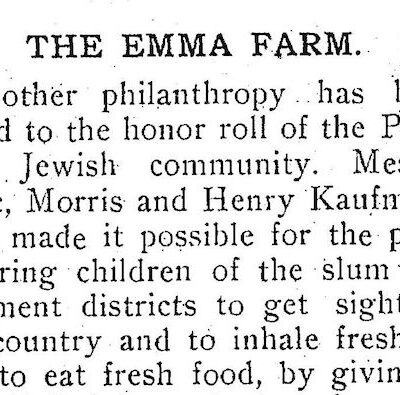
The Emma Farm Association was created to “maintain a farm in order to provide open-air recreation for children and adults and a temporary home for convalescents.” The Association was organized by a group of 33 community leaders on May 19, 1908, after Isaac and Morris Kaufmann purchased a small farm in Harmarville, Pa. for such purposes. The association was named for Isaac Kaufmann’s late wife Emma Kaufmann.
Although its sponsors and leadership came from the Jewish community, and it observed the Jewish dietary laws of kashrut at its facilities in an attempt to make the camp accessible to Orthodox members of the community, the Emma Farm Association was non-denominational and non-sectarian. In its early years, the Irene Kaufmann Settlement House, the Soho Baths Settlement, the Woods Run Industrial Home, and the United Hebrew Relief Association all referred children to the Emma Farm. The Emma Farm initially included a Farm School Department to oversee programs for juvenile delinquents and a Fresh Air Department to provide recreation for children and families.
The Emma Farm Association was one of the original beneficiaries of the Federation of the Jewish Philanthropies of Pittsburgh. Initially independent, the Emma Farm Association partnered with the Irene Kaufmann Settlement House in 1916 to provide management. Several changes were implemented under the new management arrangement, such as the introduction of enrollment fees, the elimination of private dining halls for staff, and steps to eliminate food waste and reduce overcrowding. The Farm School Department was dropped in 1918 to devote resources to the Emma Farm Camp.
To accommodate growth, the Emma Farm Camp relocated in the early 1920s to a site along the Connoquenessing Creek between Zelienople, Pa. and Harmony, Pa. The Emma Farm Association was part of a larger network of “fresh-air” camps across the country, and it evolved over the years along with wider changes in the field. The Emma Farm Association revised in bylaws in 1922. It made a series of changes in the 1940s designed to implement emerging best practices from the American Camping Association. In these years, the organization began increasingly using the name Emma Kaufmann Camp.[1]“History of the Emma Kaufmann Camp,” compiled by Sidney J. Lindenberg (online).
Following a two-year study overseen by the United Jewish Federation, the Emma Farm Association merged with the Irene Kaufmann Center and the Young Men’s and Women’s Hebrew Association in 1961. As part of the merger, the Laurel Y Camp merged its operations into the Emma Farm Camp. Emma Kaufmann Camp acquired the 200-acre Camp Lynnwood near Morgantown, W.Va. in 1971 and relocated the following year.[2]“Board Recommends Y-IKS Merger,” YM&WHA Weekly, Dec. 16, 1960, p. 1 (online—Pittsburgh Jewish Newspaper Project).
Early presidents of the Emma Farm Association include A. J. Sunstein (1912-1916), Edgar J. Kaufmann (1916-1921, 1923-1932), A. L. Rauh (1921-1923), Lilliane S. Kaufmann (1932-1934), Oliver M. Kaufmann (1934-1942), Nathan B. Jacobs (1942-1947), Harvey M. Aronson (1947-1951), and Henry D. Goldman (1951-?).[3]“History of the Emma Kaufmann Camp,” compiled by Sidney J. Lindenberg (online).